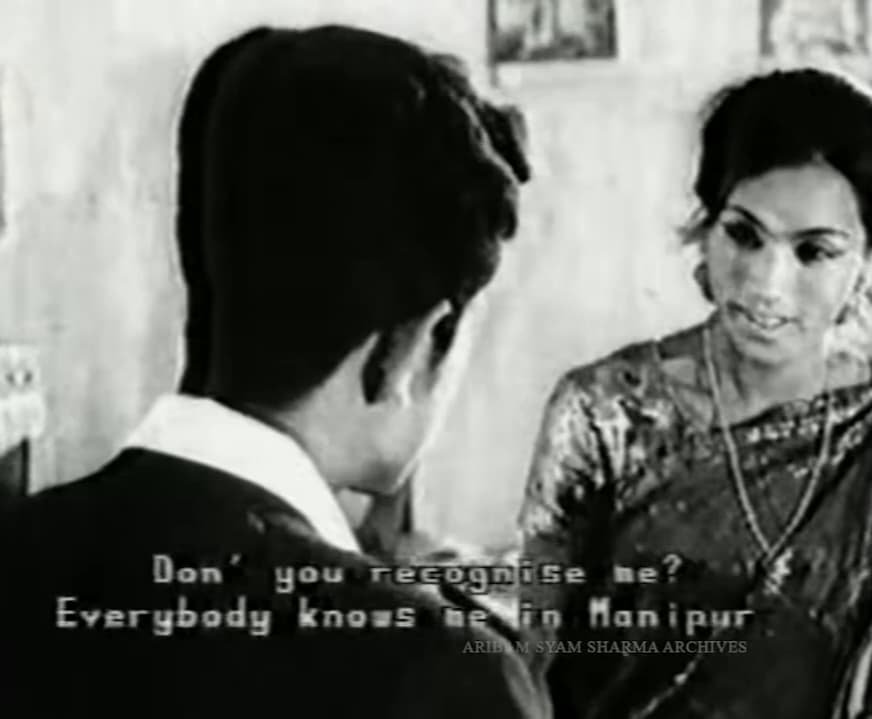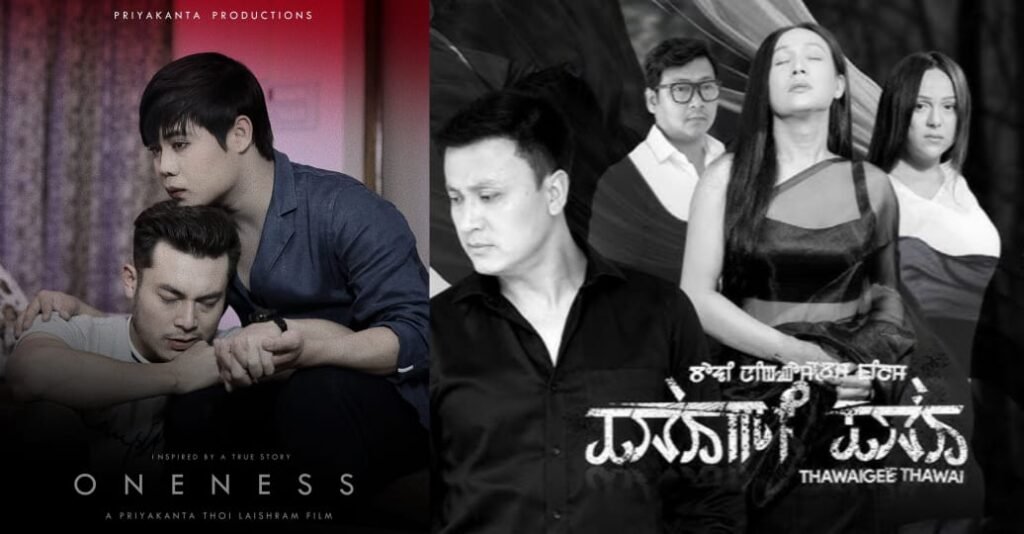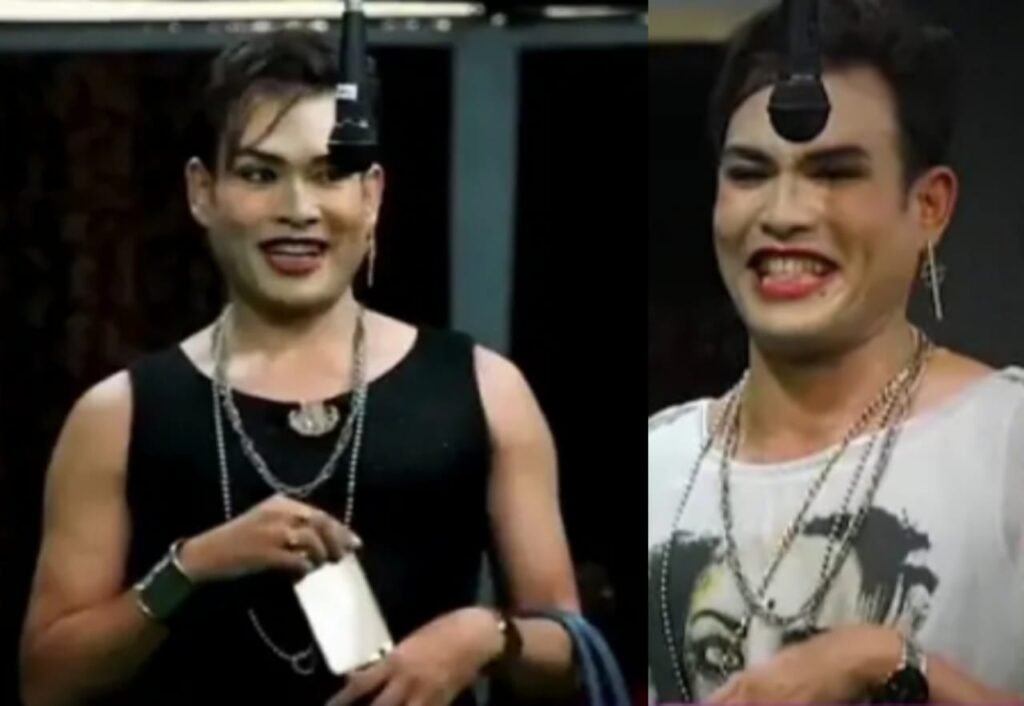In 1972, Meitei Leima Jatra Cum Drama Association, a renowned Shumang Leela troupe at the time, produced a play that would go on to enjoy considerable success. The play, whose remake over 30 years later remained a hit, was none other than ‘Abir Khan‘. The 1972 play starred Thounaojam Nobin in the role of Amina, the heroine of the play. It was only a few months later that he was roped in by film producer G Narayan Sharma of NS Films for his upcoming film ‘Lamja Parshuram‘. Unbeknownst to them, Nobin Singh’s brief yet impactful cameo in the 1974 film would become a landmark moment in Manipuri Cinema, marking the first queer representation on the silver screen.

It’s a common saying among cinemagoers that films are mirrors of the society we live in. By this logic, films should accurately represent the diversity of people groups within our society. Given the significant presence of the queer community in the state, examining its representation in Manipuri cinema becomes all the more important. This article aims to highlight queer representations in Manipuri cinema, tracing their evolution from 1974 to the present day.
Early Beginnings: 1970s-1990s:
As mentioned in the introduction, a brief cameo of a shumang leela nupi sabi in the 1974 film Lamja Parshuram marked the pioneering queer representation in Manipuri cinema. Notably, Nobin’s role is remarkably significant to the film’s narrative, and the character is not used as a comedic relief, which would sadly become the trend in later years. Nobin plays the role of an unnamed woman who visits the antagonist of the film to extract information that would eventually save the protagonist. Draped in a saree whose shine wasn’t diminished even in the black and white film, Nobin Singh’s cameo will forever be iconic.

The 1980s were a challenging period for Manipuri cinema, marked by a scarcity of film releases and a notable absence of queer representation. However, the late 1990s saw the emergence of a significant work: the full-length video film “Mera Thaagee Sanarei,” starring renowned Shumang Leela nupi sabi artists RK Sanaton and Oinam Arun.
Although “Mera Thaagee Sanarei” is a comedy film featuring parody songs and a storyline centred around a man wooing two women, its significance lies in being the only video film to feature Shumang Leela nupi sabi as the main protagonists.

The Dark Years- 2000s:
The 2000s marked a significant shift in Manipuri cinema with the rise of digital filmmaking, resulting in a surge of annual productions and increased visibility of queer characters. However, these representations were often relegated to comedic relief, lacking depth and narrative significance. Veteran actors like Kuber and Rangilal perpetuated damaging stereotypes, potentially normalizing mockery and marginalization of queer individuals in real life.
Films like Eigidi Thawaini, Huranbado Mapuni, and Thajadaba Mitkuptuda share a disturbing commonality: the use of a queer character, played by Kuber, as a comedic relief. These portrayals feature humiliation, derogatory remarks, and ridicule, perpetuating the notion that queer individuals are objects of mockery. Moreover, veteran actress Mombi’s portrayal of a woman with masculine attributes in a film from this decade earned her the title ‘CheChe Tamo‘, further highlighting the troubling trend of mocking nonconformity.
In one way or another, people of all ages would have consumed these films and the stereotypes that came with them, and this likely led to real-life stereotyping and further discrimination of an already marginalized community. In light of this, I’d categorise this decade as the ‘dark decade’ for queer representation in Manipuri films.
Shift Towards Inclusivity- 2010s:
The 2010s marked a turning point in Manipuri cinema’s portrayal of queer characters. Films like Thouri, featuring an effeminate middle-aged man working in a girls’ hostel, and Khomei, which depicts a trans woman character, played by Bonny, as a comedic relief who pursues straight men for humorous effect, continued to perpetuate stereotypes.
In contrast, films like Ang Tamo and Kaiku vs Hiramoti offered more nuanced and realistic representations. Ang Tamo explores the lives and struggles of trans women, while Kaiku vs Hiramoti tells the story of a trans woman’s journey, including sex reassignment surgery. These films signal a shift towards more sensitive and thoughtful portrayals of queer characters.
Another positive aspect of this decade is that, unlike its Bollywood counterpart, Manipuri cinema featured real-life trans women in these roles, rather than casting cisgender actresses.

Continued Progress- 2020s:
The 2020s marks a significant shift in Manipuri cinema’s portrayal of queer characters, building on the progress made in the 2010s. Director-actor Priyakanta’s film “Oneness,” released in 2024, was a landmark production as the first full-fledged gay-themed film in Manipur. Although Manipuri cinema’s acquaintance with same-sex relationships dates back to 2015 with the film “Eikhoi Pabungi,” where veteran actor Edhou briefly contemplates his son’s (played by Denny) potential gay orientation, “Oneness” pioneered an in-depth portrayal of gay relationships.
The recent release of “Thawaigi Thawai,” starring all Shumang Leela artists, further solidifies the progress in queer representation in Manipuri cinema. As an adaptation of the play of the same name, the film garnered praise from audiences, who appreciated the unique casting. This development marks a significant step towards normalizing queer representation in films, potentially contributing to a more open-minded society.

However, the film fraternity’s hostility towards queer representation and queer individuals needs a closer look. Notably, the Cine Actor Guild Manipur’s recent shumang leela performance at the prestigious Iboyaima Shumang Leela Shanglen was marred by stereotypical portrayals. Actor Bonny, known for his Shumang Leela background, played a trans woman in a derogatory manner, with veteran actresses Maya Choudhary and Lilabati endorsing his performance. It’s perplexing that these actors, associated with a platform that has provided some visibility to trans women, would perpetuate age-old stereotypes, which I consider a significant misstep.
Furthermore, the recent controversy surrounding ‘Thawaigi Thawai’, where Film Forum Manipur initially withheld permission for production and release, exemplifies the denial of representation opportunities. But hopefully, the film’s eventual release could pave the way for more inclusive storytelling and bring positive changes in this field.

It’s evident that Manipuri cinema’s portrayal of queer characters has traversed a complex path. From minor but significant roles in the 1970s to derogatory representations in later years, the industry has struggled with nuanced depiction. However, recent films like “Oneness” and “Thawaigi Thawai” signal a promising shift. To sustain this momentum, filmmakers must prioritise thoughtful representation, recognising that on-screen portrayals can either challenge or perpetuate real-world prejudices.
Daniel Yumkham | Film Critic and Researcher
Passionate about history and Manipuri culture, Daniel shares film reviews and research on:
-Manipuri Cinema (Instagram : thefilmdiary )
-Regional History and Traditions.

